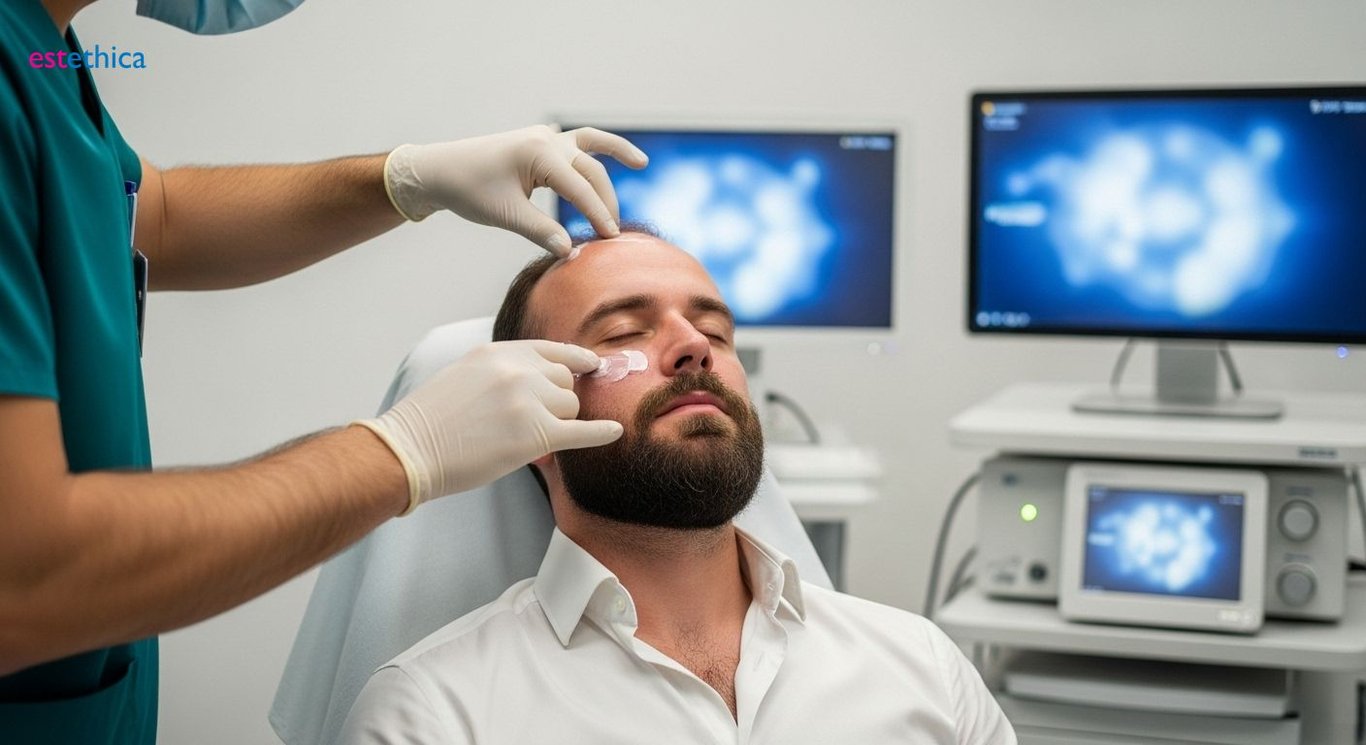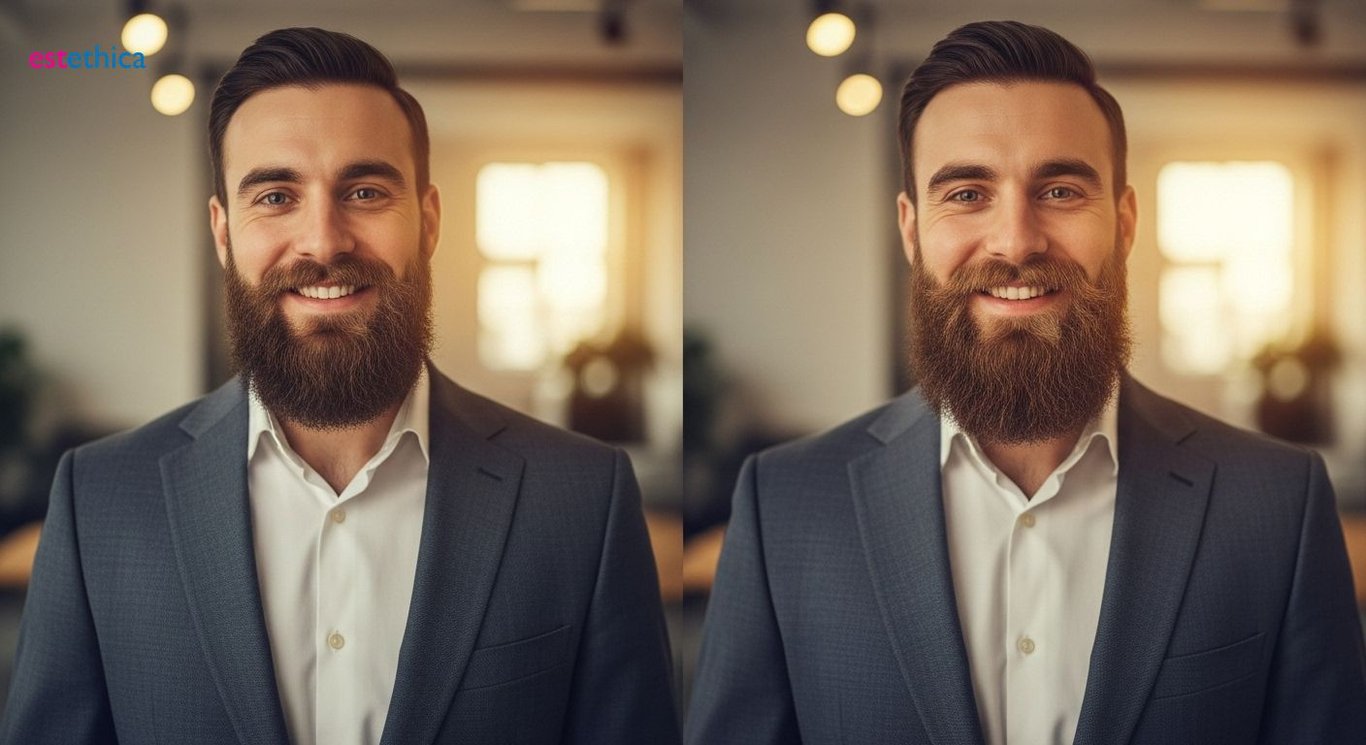Beard Implants: Grow the Confidence You Deserve
Discover the ultimate guide to beard transplants and unlock your dream facial hair look with expert insights and detailed transformations.
Explore the transformative potential of beard transplants to achieve your dream look. Learn about the procedures, recovery, and how to choose the best surgeon for this life-changing experience.
Facial Hair Transplants: What Are Your Options?
Exploring FUE and DHI Techniques for Facial Hair Restoration
Facial hair transplantation has evolved, offering procedures like FUE (Follicular Unit Extraction) and DHI (Direct Hair Implantation). Understanding these techniques is crucial for anyone considering a beard transplant. Both methods aim to restore or enhance facial hair, but they differ significantly in their approach and execution. These advancements in hair restoration provide tailored solutions to meet individual needs, whether it's filling patchy areas or creating a completely new beard.
FUE involves extracting individual hair follicles from a donor area, usually the back of the scalp, and transplanting them to the face. DHI, on the other hand, uses a specialized pen-like tool to directly implant the follicles without needing to create incisions first. The choice between FUE and DHI often depends on factors like the extent of hair loss, desired density, and the surgeon's expertise. Many individuals now seek facial hair transplant procedures to achieve their desired aesthetic outcomes.
- FUE is known for minimal scarring and a natural-looking result.
- DHI offers precise placement of follicles, potentially leading to higher density.
- Both techniques require a skilled surgeon to ensure the best possible outcome.
Understanding the Surgical Process for a Beard Transplant
The process of a beard transplant involves several key stages, starting with a consultation to assess the patient's suitability and discuss their goals. During the procedure, hair follicles are harvested from a donor area, typically the scalp, and then carefully implanted into the facial region. The angle and direction of each follicle are crucial for achieving a natural look. Post-operative care is essential for ensuring proper healing and the successful growth of the transplanted hair.
Recovery time varies, but most patients can expect some redness and swelling in the treated area for a few days. It's important to follow the surgeon's instructions closely to minimize complications and optimize results. The transplanted hair will initially fall out after a few weeks, but new hair growth will typically begin within a few months. A successful facial hair transplant can provide a permanent solution for those seeking to enhance their facial hair.
- Initial consultation and assessment of donor area.
- Extraction of hair follicles using FUE or DHI technique.
- Implantation of follicles into the beard area with precise placement.

Beard Transplant Before & After: Real Transformations
Visualizing the Impact of a Beard Transplant
The impact of a beard transplant can be truly transformative, and this is best illustrated through before and after photos. These images provide concrete evidence of the potential for significant aesthetic improvement. Viewing these transformations allows prospective patients to visualize the possibilities and understand the level of change that can be achieved. The results often showcase not only a fuller beard but also a more defined and masculine facial structure. Observing real-life examples can instill confidence and help individuals make informed decisions about pursuing a facial hair transplant.
Before and after photos highlight the artistry and precision involved in the procedure. Skilled surgeons carefully place each hair follicle to create a natural-looking density and shape. The transformations often reveal improvements in self-esteem and overall appearance. For instance, a man with a patchy beard might gain a full, even beard that enhances his jawline. Another example could be someone with minimal facial hair achieving a robust, well-defined beard that aligns with their desired look. These visual testimonials emphasize that a successful beard transplant is more than just a cosmetic procedure; it's a personal transformation.
- Increased facial hair density and even coverage.
- Enhanced definition of the jawline and facial contours.
- Improved self-confidence and overall aesthetic appearance.
Assessing Naturalness and Density in Beard Transplant Outcomes
One of the primary concerns for individuals considering beard implants is whether the results will look natural. High-quality before and after photos demonstrate that a skilled surgeon can achieve results that seamlessly blend with the patient's existing hair. Factors such as hair direction, density, and the hairline design play crucial roles in creating a natural appearance. Examining these visual outcomes can alleviate concerns and provide a realistic expectation of what can be achieved. The goal is to create a beard that looks like it has always been there.
Density is another critical aspect of a successful facial hair transplant. A well-executed procedure should provide sufficient coverage to create a full and even beard. Before and after photos often showcase how strategically placed follicles can transform a sparse or patchy beard into a dense and well-groomed one. For example, a patient who initially had thin, scattered facial hair can achieve a thick, uniform beard that enhances his overall look. Another instance might involve filling in gaps or scars in the beard area to create a more consistent and appealing appearance. Ultimately, the combination of naturalness and density contributes to a satisfying and confidence-boosting result.
- Evaluate hairline design for seamless integration with existing hair.
- Check hair direction and angle for a natural growth pattern.
- Assess density and coverage for a full and even beard appearance.

Finding the Best Beard Transplant Surgeon for You
Evaluating Surgeon Credentials and Experience
Selecting the right surgeon is paramount for a successful beard transplant. Look for board certification in relevant specialties such as dermatology or plastic surgery. Experienced surgeons will have a portfolio of successful facial hair transplant cases, demonstrating their skill and aesthetic judgment. Checking their credentials ensures they have the necessary training and expertise. The best surgeons stay updated with the latest techniques and advancements in hair restoration.
Consider a surgeon's specific experience with beard implants. Facial hair restoration requires a nuanced approach due to the unique characteristics of facial hair. A surgeon with extensive experience will understand how to create a natural-looking beard that complements your facial features. For example, they will know the precise angle and direction to implant each follicle for optimal results. Another instance is their ability to manage potential complications and ensure a smooth recovery. A skilled surgeon combines technical expertise with artistic vision to achieve the best possible outcome.
- Verify board certifications in dermatology or plastic surgery.
- Review the surgeon's portfolio of before and after photos.
- Assess their specific experience with facial hair transplants.
Assessing Clinic Technology and Patient Reviews
The technology used in a clinic can significantly impact the outcome of a beard transplant. Modern clinics employ advanced techniques like FUE and DHI, which offer precise and natural-looking results. State-of-the-art equipment ensures minimal scarring and faster recovery times. Patient reviews provide valuable insights into the quality of care and the surgeon's bedside manner. Positive reviews often highlight the surgeon's attention to detail and commitment to patient satisfaction. These factors collectively contribute to a positive and successful experience.
Look for clinics that invest in the latest technology and adhere to strict safety protocols. Clinics that prioritize patient comfort and well-being are more likely to deliver exceptional results. For example, a clinic might use advanced imaging technology to plan the transplant with precision. Another instance is the use of specialized instruments that minimize trauma to the scalp and facial skin. Reading patient reviews can reveal how well the clinic handles follow-up care and addresses any concerns. Ultimately, the combination of advanced technology and positive patient feedback is a strong indicator of a reputable and reliable clinic for facial hair transplant.
- Inquire about the specific technologies used for the transplant.
- Read patient reviews on independent platforms.
- Check for certifications and accreditations.

The Lowdown on Beard Transplant Recovery Time
Navigating the Initial Days After Your Beard Transplant
The initial days following a beard transplant are crucial for ensuring a successful outcome. Expect some redness, swelling, and minor discomfort in the treated area. Following your surgeon’s post-operative instructions is essential. This typically includes gentle cleaning of the area to prevent infection and applying prescribed ointments to aid healing. Avoid touching or scratching the transplanted area to prevent dislodging the newly implanted follicles. Proper care during this period sets the stage for optimal hair growth and minimizes potential complications. Remember, patience and diligence in these early stages are key to a positive result.
During the first week, it's advisable to avoid strenuous activities and direct sun exposure. Gentle exercises like walking are acceptable, but anything that causes excessive sweating should be avoided. Sleep with your head elevated to reduce swelling and protect the transplanted area. For instance, using a travel pillow can help maintain the correct position during sleep. Another important tip is to avoid shaving or trimming the transplanted hair for at least two weeks. These precautions help ensure that the newly implanted follicles are not disturbed and can properly integrate into the skin. Paying close attention to these details can significantly improve the success rate of your facial hair transplant.
- Gentle cleaning of the treated area with prescribed solutions.
- Avoidance of strenuous activities and direct sun exposure.
- Sleeping with the head elevated to minimize swelling.
Long-Term Expectations and Care for Your New Beard
Understanding the long-term expectations and care requirements after a beard transplant is vital for maintaining a healthy and full beard. While the initial transplanted hairs may fall out within a few weeks, new hair growth typically begins within three to four months. Full results can usually be seen within 9-12 months. Regular grooming and maintenance are essential to keep your new beard looking its best. This includes trimming, conditioning, and using appropriate beard care products. Consistent care ensures the longevity and natural appearance of your transplanted beard.
Long-term care also involves protecting your beard from damage and maintaining a healthy lifestyle. Avoid harsh chemicals and excessive heat styling, as these can weaken the hair follicles. A balanced diet and regular exercise can promote overall hair health and growth. For example, incorporating foods rich in vitamins and minerals, such as biotin and zinc, can support hair strength. Another important aspect is to schedule regular check-ups with your surgeon to monitor the progress and address any concerns. For instance, they can assess the density and growth pattern of your beard and recommend additional treatments if needed. With proper long-term care, your beard implants can provide a lasting and satisfying result.
- Regular grooming and maintenance with appropriate beard care products.
- Protection from harsh chemicals and excessive heat styling.
- Maintaining a healthy lifestyle with a balanced diet and regular exercise.
Precision FUE and DHI Techniques for Natural-Looking Facial Hair Transplants
estethica employs advanced FUE and DHI techniques for facial hair transplants, ensuring minimal scarring and natural-looking results. DHI utilizes a specialized pen-like tool for direct follicle implantation, allowing for precise placement and potentially higher density in beard restoration.
estethica's surgeons are board-certified in dermatology and plastic surgery, possessing extensive experience in facial hair restoration. They stay updated with the latest advancements in hair restoration to provide tailored solutions for each patient's unique needs.
Comprehensive Care and Advanced Technology for Optimal Beard Transplant Recovery
estethica provides comprehensive post-operative care, including gentle cleaning instructions and prescribed ointments to aid healing and prevent infection. The clinic uses state-of-the-art equipment and adheres to strict safety protocols to ensure minimal scarring and faster recovery times.
Patient reviews highlight estethica's attention to detail, commitment to patient satisfaction, and positive bedside manner. The clinic's investment in advanced imaging technology and specialized instruments minimizes trauma and ensures precise transplant planning.
Frequently Asked Questions
What is a beard transplant and how does it work?
What are the different techniques used in a facial hair transplant?
How do I find the best beard transplant surgeon for my needs?
What is the typical beard transplant recovery time and what can I expect?
What factors contribute to a successful beard transplant before and after transformation?
Achieve your aesthetic goals with estethica's personalized solutions.
📞 Book Your Consultation Now!